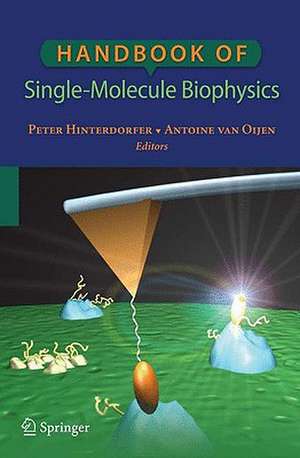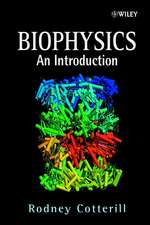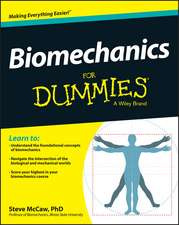Handbook of Single-Molecule Biophysics
Editat de Peter Hinterdorfer, Antoine van Oijenen Limba Engleză Hardback – 23 iul 2009
| Toate formatele și edițiile | Preț | Express |
|---|---|---|
| Paperback (1) | 1063.40 lei 39-44 zile | |
| Springer – 22 aug 2016 | 1063.40 lei 39-44 zile | |
| Hardback (1) | 1100.16 lei 39-44 zile | |
| Springer – 23 iul 2009 | 1100.16 lei 39-44 zile |
Preț: 1100.16 lei
Preț vechi: 1447.57 lei
-24% Nou
Puncte Express: 1650
Preț estimativ în valută:
210.57€ • 219.00$ • 176.46£
210.57€ • 219.00$ • 176.46£
Carte tipărită la comandă
Livrare economică 10-15 martie
Preluare comenzi: 021 569.72.76
Specificații
ISBN-13: 9780387764962
ISBN-10: 0387764968
Pagini: 626
Ilustrații: XXI, 626 p.
Dimensiuni: 155 x 235 x 33 mm
Greutate: 1.5 kg
Ediția:2009
Editura: Springer
Colecția Springer
Locul publicării:New York, NY, United States
ISBN-10: 0387764968
Pagini: 626
Ilustrații: XXI, 626 p.
Dimensiuni: 155 x 235 x 33 mm
Greutate: 1.5 kg
Ediția:2009
Editura: Springer
Colecția Springer
Locul publicării:New York, NY, United States
Public țintă
ResearchDescriere
During the last decade, a number of novel biophysical methods have been developed that allow the manipulation and study of individual biomolecules. The ability to monitor biological processes at the fundamental level of sensitivity, that of a single molecule, has given rise to an improved understanding of the underlying molecular mechanisms. Through the removal of ensemble averaging, distributions and fluctuations of molecular properties can be characterized, transient intermediates identified, and catalytic mechanisms elucidated. By applying forces on biomolecules while monitoring their activity, important information can be obtained on how proteins couple function to structure. The Handbook of Single-Molecule Biophysics provides an introduction to these techniques and presents an extensive discussion of the new biological insights obtained from them.
Editorial Advisory Board: Daniel Müller, Cheng Zhu, Claus Seidel, Xiaowei Zhuang, Thomas Schmidt, Nynke Dekker.
Editorial Advisory Board: Daniel Müller, Cheng Zhu, Claus Seidel, Xiaowei Zhuang, Thomas Schmidt, Nynke Dekker.
Cuprins
Chapter 1 - Single-molecule fluorescence trackingAhmet Yildiz (UCSF)Chapter 2 - Single molecule studies in the membraneGerhard Schuetz (Linz)Thomas Schmidt (Leiden)Chapter 3 - Single-molecule imaging in live cellsJie Xiao (Johns Hopkins)Chapter 4 - Superresolution imagingXiaowei Zhuang (Harvard)Chapter 5 - Fluorescence Resonance Energy TransferAchillefs Kapanidis (Oxford) Chapter 6 - Single-molecule enzymologyAntoine van Oijen (Harvard)Chapter 7 - Rotary proteinsRichard Berry (Oxford) Chapter 8 - Fluorescence Correlation SpectroscopyPetra Schwille (Dresden) Chapter 9 - Advanced Concepts of Fluorescence Fluctuation SpectroscopyJörg Enderlein (Tübingen) Chapter 10 - Nucleic-acid analysis at the single-molecule levelAmit Meller (Boston University)Chapter 11 - Nanopores: Geneneration and Single-Molecule ApplicationsStefan Howorka (UCL)Zuzanna Siwy (UC-Irvine)Chapter 12 - Optical trappingMichael Woodside (Alberta)Megan Valentine (UCSB)Chapter 13 - Magnetic tweezingNynke Dekker (Delft)Chapter 14 - Protein/DNA unfoldingMatthias Rief (Munich) Chapter 15 - Single molecule recognitionZiv Reich (Weizman)Peter Hinterdorfer (Linz)Chapter 16 - Nano-scale AFM imagingSimon Scheuring (Institut Curie)Daniel J. Müller (Dresden)Chapter 17 - High Speed AFMT. Ando (Kanazawa) Chapter 18 - Recognition imagingYves Dufrene (Leuven) Peter Hinterdorfer (Linz)Chapter 19 - Atomic force microscopy of protein-protein interactionsVincent Moy (Miami) Chapter 20 - A New Approach to Analysis of Single MoleculeForce MeasurementsEvan Evans (Vancouver) Chapter 21 - Single Molecule Recognition: Extracting Information from Individual Binding Events and Their CorrelationCheng Zhu (Georgia Tech)
Recenzii
From the reviews:“The Handbook of Single-Molecule Biophysics, edited by Hinterdorfer (Johannes Kepler Univ. of Linz, Austria) and van Oijen (Harvard Medical School), contains 21 chapters that address various aspects of techniques used to investigate single-molecule biophysics. The chapters, many authored by leading experts in their respective fields, cover specialized biophysical techniques, their applications, background into the technical design, and practical aspects of implementing these approaches. … Summing Up: Recommended. Graduate students, researchers, faculty, and professionals.” (C. A. Reinhart-King, Choice, Vol. 47 (10), June, 2010)
Textul de pe ultima copertă
The last decade has seen the development of a number of novel biophysical methods that allow the manipulation and study of individual biomolecules. The ability to monitor biological processes at this fundamental level of sensitivity has given rise to an improved understanding of the underlying molecular mechanisms. Through the removal of ensemble averaging, distributions and fluctuations of molecular properties can be characterized, transient intermediates identified, and catalytic mechanisms elucidated. By applying forces on biomolecules while monitoring their activity, important information can be obtained on how proteins couple function to structure. The Handbook of Single-Molecule Biophysics provides an introduction to these techniques and presents an extensive discussion of the new biological insights obtained from them. Coverage includes:
- Experimental techniques to monitor and manipulate individual biomolecules
- The use of single-molecule techniques in super-resolution and functional imaging
- Single-molecule studies of physical properties of biomolecules
- Single-molecule enzymology and biochemistry
- Single molecules in the membrane
- Single-molecule techniques in living cells
- Integration of single-molecule biophysics and nanoscience
Caracteristici
Describes experimental techniques to monitor and manipulate individual biomolecules, including fluorescence detection, atomic force microscopy, and optical and magnetic trapping
Addresses the use of single-molecule techniques in super-resolution and functional imaging
Includes single-molecule studies of physical properties of biomolecules such as folding, polymer physics of protein and DNA, enzymology and biochemistry, single molecules in the membrane, and single-molecule techniques in living cells
Integrates single-molecule biophysics and nanoscience
Addresses the use of single-molecule techniques in super-resolution and functional imaging
Includes single-molecule studies of physical properties of biomolecules such as folding, polymer physics of protein and DNA, enzymology and biochemistry, single molecules in the membrane, and single-molecule techniques in living cells
Integrates single-molecule biophysics and nanoscience










